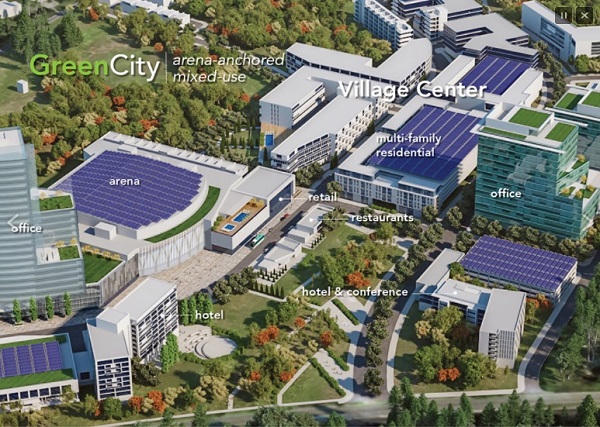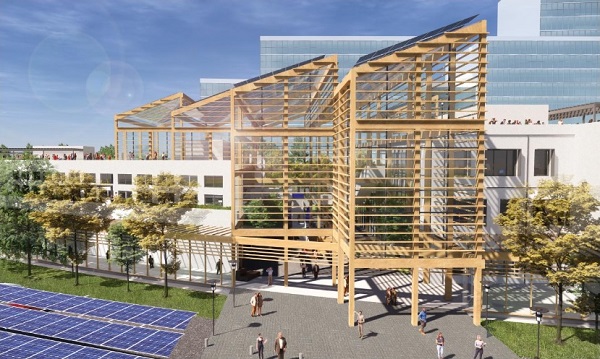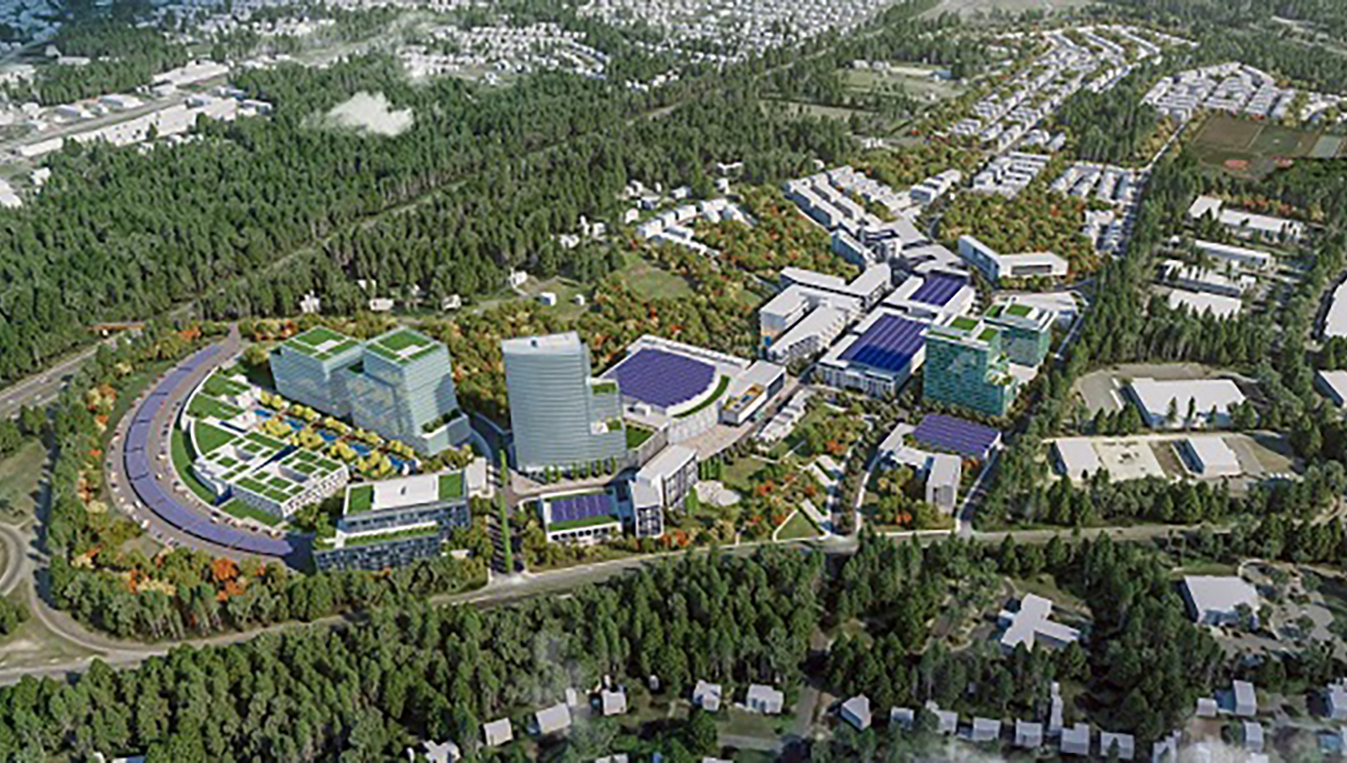
Conceptual renderings show the arena in relation to other buildings in the proposed GreenCity mixed-use development. (Images courtesy of Henrico County)
Behind-the-scenes steps continue to be taken in the lead-up to GreenCity, the massive mixed-use, arena-anchored development in the works in Henrico County.
At the same time, more about the project and its vision as a so-called “ecodistrict” village is being put into public view.
Developers behind the $2.3 billion plan have submitted their application for a rezoning of the land that includes the county-owned Best Products site at Interstate 95 and Parham Road.
The request, which was filed in mid-June and is under review by county planning staff, seeks to designate the entire 200-acre project site under Henrico’s Urban Mixed-Use district, which would accommodate the mix of commercial, residential and office uses that would make up GreenCity.
The application includes a master site plan and design pattern book, which details the development’s various components. It does not yet include a traffic impact analysis (TIA), a required document that remains in the works.
In recent days, developers launched a dedicated website for the project, with the master site plan and design pattern book included. The 134-page document, along with other project details, can be viewed on the site, GreenCityVA.com.
Joe Emerson, Henrico’s planning director, said his staff is in the process of reviewing the application, which has been distributed to various departments. He said the case could go before the Planning Commission as early as September, depending on when the TIA is provided.
Final zoning approval would come from the Board of Supervisors, which likewise would hold a public hearing before a vote. Roth Jackson attorney Andy Condlin is representing the developers in the process.

A rendering of the former Best Products headquarters repurposed as a “living building” with sustainable development features such as solar energy panels.
‘Living building’ development
Announced in December, GreenCity is planned to consist of 2.2 million square feet of office space, 280,000 square feet of retail, two 300-room hotels, green space, and up to 2,400 residential units.
The development would be anchored by a $250 million, 17,000-seat arena that would effectively replace the shuttered Richmond Coliseum, which the city is preparing to demolish.
The GreenCity arena, the first hotel and other initial development are targeted for completion in 2025, with full buildout anticipated in 2033.
Initial development would include repurposing the 300,000-square-foot former Best Products headquarters as a so-called “living building,” meaning it would generate more energy than it would use, among other environmental sustainability features.
Michael Hallmark, one of the developers behind GreenCity and a principal with Richmond-based Future Cities, has said he is planning to submit the Best Products project for consideration in the Living Building Challenge, a recognition program under the Seattle-based International Living Future Institute.
If successful, the project would be the largest commercial “living building” in the world, he said.
“That could influence other developments going forward. It could be very consequential,” Hallmark said this week.
Land purchases, CDA to follow
Next steps in the process include acquisition of the Best Products site, as well as the rest of the land to the north known as Scott Farm, which would be purchased from Bill Goodwin’s Riverstone Properties.
The purchase of the county-owned Best Products site is contingent on the rezoning, said Anthony Romanello, Henrico’s economic development director.
Earlier this year, county supervisors transferred the site’s ownership to the county’s economic development authority, which Romanello said has signed a purchase agreement with the development entity, GreenCity LLC.
The purchase agreement is based on a sale price of $6.2 million, the amount the county paid for the 92-acre property in 2011.
The remaining acreage would involve a separate transaction between Riverstone and GreenCity LLC. Riverstone bought its land in 2015 for more than $6.4 million.
Other steps include the establishment of a community development authority (CDA) for the project site that would generate tax revenue to support the development as it progresses. Romanello said the CDA would likewise follow the rezoning later this fall.
Henrico has used CDAs for other developments such as Short Pump Town Center, White Oak Village and Reynolds Crossing. Thirty-year bonds used to finance GreenCity would be paid off with tax revenue from the development’s initial phases, as well as from revenues generated from the arena.
The scenario is different than the former Navy Hill proposal, which hinged on taxpayer support through a proposed tax-increment financing district. That plan, which a majority of the Richmond City Council rejected last year, was centered on a new arena to replace the Coliseum.
Hallmark, who has designed multiple arenas across the country, was part of the development team behind Navy Hill along with GreenCity collaborator Susan Eastridge of Concord Eastridge, a Fairfax-based firm that focuses on public-private and mixed-use developments.
Downtown project site acquired
Hallmark and Eastridge also are leading the redevelopment of one of the downtown city blocks previously involved in Navy Hill: the former Public Safety Building site at 500 N. 10th St., where their Capital City Partners LLC is planning a 20-story, VCU Health-anchored tower and mixed-use office complex.
Capital City Partners closed on the 3-acre property last month, fulfilling a $3.52 million purchase agreement that the City Council approved in March.

Conceptual renderings show the arena in relation to other buildings in the proposed GreenCity mixed-use development. (Images courtesy of Henrico County)
Behind-the-scenes steps continue to be taken in the lead-up to GreenCity, the massive mixed-use, arena-anchored development in the works in Henrico County.
At the same time, more about the project and its vision as a so-called “ecodistrict” village is being put into public view.
Developers behind the $2.3 billion plan have submitted their application for a rezoning of the land that includes the county-owned Best Products site at Interstate 95 and Parham Road.
The request, which was filed in mid-June and is under review by county planning staff, seeks to designate the entire 200-acre project site under Henrico’s Urban Mixed-Use district, which would accommodate the mix of commercial, residential and office uses that would make up GreenCity.
The application includes a master site plan and design pattern book, which details the development’s various components. It does not yet include a traffic impact analysis (TIA), a required document that remains in the works.
In recent days, developers launched a dedicated website for the project, with the master site plan and design pattern book included. The 134-page document, along with other project details, can be viewed on the site, GreenCityVA.com.
Joe Emerson, Henrico’s planning director, said his staff is in the process of reviewing the application, which has been distributed to various departments. He said the case could go before the Planning Commission as early as September, depending on when the TIA is provided.
Final zoning approval would come from the Board of Supervisors, which likewise would hold a public hearing before a vote. Roth Jackson attorney Andy Condlin is representing the developers in the process.

A rendering of the former Best Products headquarters repurposed as a “living building” with sustainable development features such as solar energy panels.
‘Living building’ development
Announced in December, GreenCity is planned to consist of 2.2 million square feet of office space, 280,000 square feet of retail, two 300-room hotels, green space, and up to 2,400 residential units.
The development would be anchored by a $250 million, 17,000-seat arena that would effectively replace the shuttered Richmond Coliseum, which the city is preparing to demolish.
The GreenCity arena, the first hotel and other initial development are targeted for completion in 2025, with full buildout anticipated in 2033.
Initial development would include repurposing the 300,000-square-foot former Best Products headquarters as a so-called “living building,” meaning it would generate more energy than it would use, among other environmental sustainability features.
Michael Hallmark, one of the developers behind GreenCity and a principal with Richmond-based Future Cities, has said he is planning to submit the Best Products project for consideration in the Living Building Challenge, a recognition program under the Seattle-based International Living Future Institute.
If successful, the project would be the largest commercial “living building” in the world, he said.
“That could influence other developments going forward. It could be very consequential,” Hallmark said this week.
Land purchases, CDA to follow
Next steps in the process include acquisition of the Best Products site, as well as the rest of the land to the north known as Scott Farm, which would be purchased from Bill Goodwin’s Riverstone Properties.
The purchase of the county-owned Best Products site is contingent on the rezoning, said Anthony Romanello, Henrico’s economic development director.
Earlier this year, county supervisors transferred the site’s ownership to the county’s economic development authority, which Romanello said has signed a purchase agreement with the development entity, GreenCity LLC.
The purchase agreement is based on a sale price of $6.2 million, the amount the county paid for the 92-acre property in 2011.
The remaining acreage would involve a separate transaction between Riverstone and GreenCity LLC. Riverstone bought its land in 2015 for more than $6.4 million.
Other steps include the establishment of a community development authority (CDA) for the project site that would generate tax revenue to support the development as it progresses. Romanello said the CDA would likewise follow the rezoning later this fall.
Henrico has used CDAs for other developments such as Short Pump Town Center, White Oak Village and Reynolds Crossing. Thirty-year bonds used to finance GreenCity would be paid off with tax revenue from the development’s initial phases, as well as from revenues generated from the arena.
The scenario is different than the former Navy Hill proposal, which hinged on taxpayer support through a proposed tax-increment financing district. That plan, which a majority of the Richmond City Council rejected last year, was centered on a new arena to replace the Coliseum.
Hallmark, who has designed multiple arenas across the country, was part of the development team behind Navy Hill along with GreenCity collaborator Susan Eastridge of Concord Eastridge, a Fairfax-based firm that focuses on public-private and mixed-use developments.
Downtown project site acquired
Hallmark and Eastridge also are leading the redevelopment of one of the downtown city blocks previously involved in Navy Hill: the former Public Safety Building site at 500 N. 10th St., where their Capital City Partners LLC is planning a 20-story, VCU Health-anchored tower and mixed-use office complex.
Capital City Partners closed on the 3-acre property last month, fulfilling a $3.52 million purchase agreement that the City Council approved in March.





What is missing in the renderings shown in this article is where the 17,000 people will park on game days or show dates. I’ll look at the Masterplan to see how that’s addressed.
The traffic study is a critical component as well as addressing public transportation.
100% agreed on the need to address public transportation options – and a traffic study (which I would hope the county has already conducted by this point). One point of concern I could see is the impact on traffic that the main entry/exit point is off of Parham Road. There is no direct access from I-295 or at least from the northern end of the development. Parham Road could become a choke point for traffic on game nights. (I’ll be curious to see how that will fly with residents of the older, single-family neighborhoods immediately to the south of Parham… Read more »
All for economic development and I hope this is a success, but very concerned about traffic in this area. Parham Rd is not equipped to handle the traffic anticipated on event days. I live in a sub-division right off Parham and I can see traffic bleeding into the neighborhood and also parking on side streets. The county needs to ensure homeowners of their plan to address increased traffic problems. I think we deserve a clear plan to ensure minimal disruption.
I am continually amazed that ‘traffic and parking’ are the first objections to any proposed development in RVA. Anyone remember the negotiations between UR and nearby neighborhood associations over building a stadium on campus? I live nearby and hardly notice a difference on game days. Not to say it isn’t a concern, but what about visioning how public transportation, autonomous vehicles, and other technology innovations sure to come, will alleviate the simple problem of getting people to and from the arena! I applaud the vision and big thinking of Capital City and Henrico County to develop amenities for this region… Read more »
Point taken, I am totally supportive of economic development. I felt the Navy Hill project was one that would change this region for the better, and I’m excited about Green City. You bring up great examples of how the traffic concerns can be addressed. My concern is we haven’t heard from the Henrico leadership how traffic will be addressed. Parham Rd is not constructed to handle the traffic associated with such a project. If that is addressed, I say full stream ahead! Traffic is always going to be a point of emphasis in any project of this size, folks living… Read more »
“Anyone remember the negotiations between UR and nearby neighborhood associations over building a stadium on campus? I live nearby and hardly notice a difference on game days.” This facility isn’t going to be a seldom used sparsely attended speciality event facility. To be a success this facility will have to have concerts and events on a weekly basis. The old single family developments off Parham don’t have the political clout and NIMBY instincts the monied class around CCV and UR do. Peace and quiet in the areas around Green city are lambs to the slaughter. I’m sure people will say… Read more »
Mr. Christina, you articulated what I was trying to say earlier. This area will be open throughout the year, not like a football stadium that host at most 8 games per year on a Saturday afternoon. We need more answers from county leadership. I do believe that if we come together as a community we can get the answer we need.. my worry is that the community is disengaged snd this project is on a run away train.
Just a note to those developing elsewhere in the region:
Any of the ‘green’ aspects of this proposal can be done in other settings. You too can plan to put PV on roofs, you can plan for rainwater retention, you too can plan with public transportation. There’s nothing magic about any of these. Seeing flagship buildings being built without LEED or other certification should not be acceptable in 2021.
I disagree about the certification part. Besides a money grab by USGBC, all of the same green achievements can be obtained without spending additional money for the overhead admin costs of the certifications. Any one can be “green”, the plaque is completely optional.
This makes sense to me, but are there many examples of developments that check all the LEED-certified boxes but then just don’t bother to go forward getting certified?
I’m definitely on board with the idea that various certifications are basically moneygrabs, but I’m also skeptical that many developers are bothering to obtain all the “green achievements” out of the goodness of their hearts without getting the certification.
Genuinely curious about this.